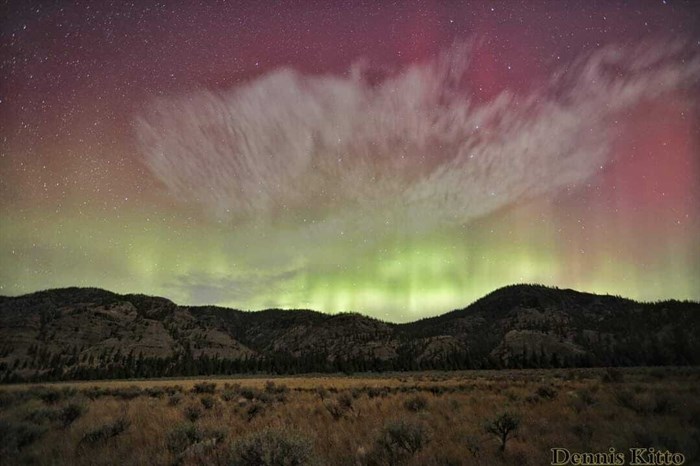
Your chances at seeing an aurora borealis are higher this year than they have been in the last 11 years.
Image Credit: SUBMITTED/Dennis Kitto
March 10, 2024 - 7:00 PM
If you've always dreamed of seeing the northern lights, you could get lucky this year as an increase in solar activity is expected.
This year, a rise in solar activity could cause an increase in aurora borealis occurrences and people across the Thompson-Okanagan region will most likely have a higher chance of seeing one of nature's light shows.
"The odds at seeing the northern lights in the Thompson-Okanagan are pretty good, but you're not going to see them every time there's a clear night, you're going to have to go out and have a look and be patient and you have to keep your eyes open," Colin Taylor, a professor in the physics department at Thompson Rivers University says.
"You need a location where you have a clear view of the north because they're generally up in the higher latitudes."
To understand why the aurora borealis could be more common this year, it's important to first understand what causes them.
"You need solar activity. The sun sends out a constant stream of charged particles throughout the solar system and those strike the Earth, but not the surface because they are deflected by our magnetic field," Taylor says.
"Some of them reach close enough down to the Earth's surface near the poles. When those particles hit the atmosphere near the poles, it will ionize the atmosphere and that creates the different colours that you see when you look at an aurora."
This year is special because of the sun's cycle reaching its peak.
"The sun has about an 11-year cycle and we're near a solar maximum right now," he says. "Every 11 years or so the solar activity increases and then it falls off, and it does so in a cycle and it's supposed to peak sometime later this year which is why we could see more aurora than usual in the next few months."
Predicting the northern lights remains an impossible task. A mixture of luck and patience seems to be the key to viewing them.
"There's no specific time, it's impossible to nail down when it will happen. A lot of it has to do with the weather, the intermittent causes of solar activities and where you are located," Taylor says. "We have satellites that track solar activity, but the sun activity remains unpredictable."
Dennis Kitto, a Kamloops photographer, agrees.
"I have friends that use an app to try and track them, but I don't find the apps to be all that accurate, it all comes down to if Mother Nature will provide you or not," he says.
"I'll usually go in the grasslands up in Batchelor Heights (in Kamloops), but anywhere north facing is typically the best way to start looking for them."
To Kitto, who's seen and photographed many aurora borealis light shows, there isn't necessarily a perfect place or time to see them.
"I've taken some of my nicest photos down right by Riverside Park where there's still a little light pollution and I manage to see them and take pictures of them from the city. It all depends on what perspective you want to get of them," Kitto says.
"I see them in the summertime once in a while, and they're especially more vibrant in the cold, but really, you can see them anywhere, especially towards the north like near Mount Lolo or Baldy Mountain."
When it comes to capturing the lights, Kitto uses high-quality equipment but says a cellphone can do if it's just to capture the memory.
"For myself, I use my Canon 5D Mark III, I use a 14 mm 2.8 lens, anything with a wide aperture lens will help bring that light in. For time exposure it depends on the brightness of the lights, sometimes 30 seconds could be too bright sometimes it could be just perfect, but you have to play around with it and see what comes up the best," he says.
"A good camera definitely helps but cell phones can do it, especially if you have a tripod, it really helps. It's if you want to start blowing up the pictures then you'll need to start spending more money on a good camera."
The show can last as little as ten minutes to all night long. Kitto says that the lights he's seen have mostly lasted anywhere from two to four hours.
To view the light show, it is best to find a spot that looks out towards the north.
In Kelowna, Knox Mountain Park is said to be a good spot, in Penticton the Munson Mountain lookout and in Lake Country looking towards Vernon is said to be optimal. Ultimately, they can be seen pretty much anywhere that is north-facing, but both Taylor and Kitto recommend patience.
To contact a reporter for this story, email Gabrielle Adams or call (438) 830-1211 or email the editor. You can also submit photos, videos or news tips to the newsroom and be entered to win a monthly prize draw.
We welcome your comments and opinions on our stories but play nice. We won't censor or delete comments unless they contain off-topic statements or links, unnecessary vulgarity, false facts, spam or obviously fake profiles. If you have any concerns about what you see in comments, email the editor in the link above. SUBSCRIBE to our awesome newsletter here.
News from © iNFOnews, 2024